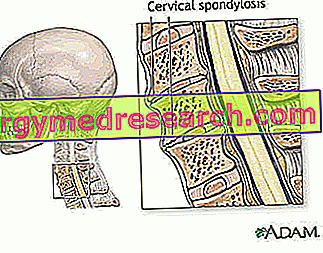Generality
Fabry disease is a rare inherited genetic disorder caused by the mutation of the GLA gene.

Figure: structure of alpha-galactosidase A.
The GLA gene is located on the X chromosome and codes for an enzyme called alpha-galactosidase A. This enzyme has a fundamental role in the process of breaking down a lipid, known as globotriesosylceramide.
In people with Fabry disease, the enzyme alpha-galactosidase A works poorly; Consequently. the globotriesosylceramide molecules tend to accumulate abnormally inside some intracellular organelles - the lysosomes - with severe suffering for the cells involved.
Fabry disease is responsible for clinical manifestations at neurological, dermatological, ocular, gastrointestinal, cerebrovascular, renal and cardiac levels.
To diagnose Fabry syndrome with absolute certainty, an appropriate genetic test is essential.
At present, there are no therapies capable of specifically curing Fabry syndrome, but only treatments of a symptomatic nature (ie aimed at alleviating symptoms).
Among these symptomatic treatments, the most important is enzyme replacement therapy, which involves the administration of an analogue, created in the laboratory, of the enzyme alpha-galactosidase A.
What is Fabry's disease?
Fabry disease is the hereditary genetic disease resulting from the accumulation, in the wall of blood vessels, in tissues and organs, of a particular type of lipid, called globotriesosilceramide .
Fabry disease is a sphingolipidosis and is part of the heterogeneous group of so-called lysosomal storage diseases .
Significance of sphingolipidosis and lysosomal storage disease
Briefly, lysosomal storage diseases are a group of about 50 rare inherited diseases, having in common the malfunctioning of a particular category of intracellular organelles: lysosomes . This malfunction depends on an enzyme deficiency and leads to the abnormal accumulation, within the lysosomes themselves, of lipids or glycoproteins, with consequent loss of cellular function.
Turning then to sphingolipidosis, these are particular lysosomal storage diseases, characterized by the harmful accumulation, within the lysosomes, of some specific sphingolipids .
A sphingolipid is a lipid, whose molecular formation involves a sphingosine molecule.
What is the task of lysosomes?
Lysosomes are small vesicles, typically present within eukaryotic cells, which have the task of degrading and digesting foreign molecules, macromolecules or substances no longer useful to the cell.
Lysosomes can be defined as the digestive system of the eukaryotic cell.
Other names of Fabry disease
Fabry's disease is known by several other names, which are:
- Anderson-Fabry disease ;
- Diffuse angiokeratoma ;
- Alpha-galactosidase A deficiency .
Causes
Prerequisite: the human chromosomal kit includes two sex chromosomes: the X chromosome and the Y chromosome .
Two particular combinations of X and Y determine the gender of an individual: the XX combination, which characterizes the female sex, and the XY combination, which distinguishes the male sex .
Fabry disease occurs due to mutations in the GLA gene, located on sex chromosome X.
Under normal conditions (therefore in the absence of mutations), this gene encodes (ie produces) a lysosomal enzyme, called alpha-galactosidase A, which has a fundamental role in breaking down the aforementioned globotriesosylceramide, a sphingolipid, into simpler components.
In people with Fabry disease, however, the mutated GLA gene produces less alpha-galactosidase A than necessary and this involves the progressive accumulation of intact (ie not broken down) globotriesosylceramide molecules, inside the lysosomes, with consequent damage and suffering for the cells involved.
In other words, while in people with healthy GLA we are seeing the correct decomposition of the globotriesosylceramide inside the lysosomes, in people with mutated GLA the same process of decomposition is insufficient to meet the needs of a cell, which, for this reason, he's sick.
Which organs and tissues are most affected by GLA mutations
In subjects with Fabry disease, the cells of the human body that are most affected by GLA mutations are:
- The cells that make up the wall of blood vessels,
- Kidney cells,
- Heart cells e
- The cells of the nervous system (neurons).
This information is important to understand the reason for the symptomatology that characterizes Fabry's disease.
Inheritance
Fabry disease is an example of an X-linked recessive inherited disease, just like haemophilia .
The particularity of recessive hereditary diseases linked to the X chromosome is that, in order for them to manifest with severe symptoms, all the X chromosomes of each cell must possess the same mutated gene. This has several implications:
- Women with only one X chromosome presenting the genetic mutation are generally in perfect health (except in rare cases), but carriers of the hereditary disease.
In these individuals - who are called "healthy carriers" - the total or almost total lack of a symptomatology is due to the fact that the healthy X chromosome compensates for the anomalous behavior of the mutated X chromosome.
- Male individuals who are born from the union between a healthy man and a healthy carrier have a 50% chance of being sick. These subjects, in fact, inherit the X chromosome from the mother and this chromosome can be either the mutated one or the healthy one.
In men, the described chromosomal compensation phenomenon does not exist for healthy carriers, since the X chromosome is only one.
- The only sick women are women with both mutated X chromosomes. In these situations, in fact, there is no chromosomal compensation and the situation is comparable to that of man with his X chromosome presenting the genetic mutation.
It should be specified that the presence of two mutated X chromosomes in a woman is a real rarity, as it requires the unlikely union between a sick man and a healthy carrier woman.
- In light of what was stated in the previous points on chromosomal compensation and the improbability of the union between a sick man and a healthy carrier, recessive hereditary diseases linked to the X chromosome are much more easily observable in male subjects.
Fabry's disease respects, almost entirely, each of the above points: the only discrepancy - if we want to call it this - concerns healthy carriers, which more frequently show a non-negligible symptomatology compared to what happens for other hereditary diseases of the same guy.
Epidemiology
Fabry disease is one of the most common lysosomal storage diseases.
If, due to its incidence in the male population, there is a fairly reliable estimate (1 case for every 40, 000-60, 000 newborns), due to its incidence in the female population there are very few reliable data.
According to some studies related to the diffusion in the various races of the world, it seems that Fabry's disease affects all the ethnic groups of the world, with a slight preference for the white race.
Symptoms and complications
From a symptomatological point of view, Fabry's disease appears in early childhood, with very mild manifestations that are difficult to catch, sometimes even on the part of an experienced eye.
Over the years, the problems become more evident and affected people suffer more; at this stage, even the identification of the disease by physicians is simpler.
The typical symptoms and signs of Fabry disease are:
- Pain in the extremities of the limbs (hands and feet) and gastrointestinal pain .
Also known as acroparestesia, pain in the extremities of the limbs would seem to be linked to damage to some peripheral nerves. Gastrointestinal pain, on the other hand, would seem to derive from a malfunctioning of the blood vessels that supply the organs of the gastrointestinal tract;
- Dark spots on the skin . These spots appear in clusters and are called angiokeratomas ;
- Anhidrosis, which is the inability to secrete sweat, or hypohydrosis, which is the abnormal reduction in sweating;
- Corneal opacity . Also known as cornea verticillata, the corneal opacity that distinguishes Fabry disease does not compromise the patient's visual abilities;
- Hearing problems . Among these are tinnitus and a certain degree of deafness;
- Dizziness ;
- Nausea ;
- Sense of recurrent fatigue ;
- Diarrhea .

Figure: angiokeratoma in a patient with Fabry syndrome.
Complications of Fabry's disease
At an advanced stage, Fabry disease tends to involve important anatomical organs and structures, such as the kidneys, heart and cerebral blood vessels, causing them damage and impairing their function.
The main consequences of involvement of the kidneys, heart and cerebral blood vessels, by Fabry disease, are:
- Heart diseases, such as myocardial infarction, cardiac arrhythmias, valvulopathies, restrictive cardiomyopathy, heart failure etc. They are the result of the massive accumulation of globotriesosilceramide in the cells of the heart and often lead to death.
- Renal failure . Similarly to the case of heart diseases, it derives from the massive accumulation of globotriesosylceramide in renal cells and represents an important cause of death.
- The predisposition to episodes of thrombosis, stroke, transient ischemic attacks, etc.
Complete collection of all the symptoms, signs and complications of Fabry disease | |
| Neurological manifestations |
|
Dermatological manifestations |
|
Gastrointestinal manifestations |
|
Ocular manifestations |
|
Cerebrovascular manifestations |
|
Cardiac manifestations |
|
Renal manifestations |
|
Diagnosis
Fabry disease is a difficult condition to diagnose, especially in the first decade of the patient's life.
In general, to formulate a correct diagnosis of Fabry disease, the following are fundamental: a thorough physical examination, a careful history, the study of the patient's family history, the enzymatic assay for measuring the activity of alpha-galactosidase A in leukocytes and a genetic test.
The latter is the diagnostic test that eliminates any doubt, in case of any suspicion, and that allows to establish the precise connotations of the mutation against the GLA gene.
Therapy
The treatment of Fabry disease consists of a substitutive enzyme therapy, which involves the administration to the patient of a replica, created in the laboratory, of the original missing enzyme, namely alpha-galactosidase A.
Thus, the purpose of enzyme replacement therapy is to provide patients with something that is able to mimic the functions of the normal, physiological enzyme.
Enzyme replacement therapy, studied for Fabry disease, does not allow treatment of the latter - unfortunately, the GLA mutation remains throughout life - but allows the alleviation of the entire symptomatology (pain in particular) with good results. For more information, see the medicine sheets:
- Fabrazyme
- Replagal
- Galafold
Other treatments
It is very common that, in addition to enzyme replacement therapy, doctors also prescribe:
- The administration of painkillers;
- Taking medicines against gastrointestinal problems;
- The administration of blood thinning drugs and drugs for the regularization of the heart rhythm;
- A pharmacological treatment against hypertension;
- Dialysis.
In the presence of severe renal insufficiency, the bases could exist for resorting to kidney transplantation .
Prognosis
For men with Fabry syndrome, the average life expectancy is 58.2 years, compared to 74.7 years for healthy males.
For women with Fabry syndrome, however, the average life expectancy is 75.4 years compared to 80 years for healthy females.
As is evident from these numerical data, in women, the disease is less severe than in men.
Among people with Fabry syndrome, heart disease is the leading cause of death.



